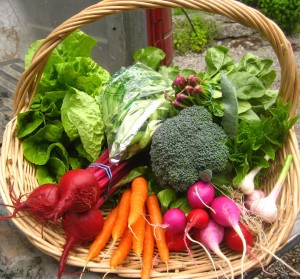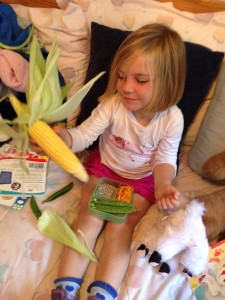The Annual Report of the Santa Cruz Food What? youth empowerment program arrived in my mailbox this weekend. Last fall a friend invited me to their annual fundraiser, and by making a modest donation (how could I not, after that delicious dinner prepared by the youth participants?) I found myself on the mailing list.
Food What! partners with “low-income and struggling youth to grow, cook, eat and distribute healthy, sustainably raised food and address food justice issues in our community.” As I turned the pages of the booklet and reviewed the activities of these teenagers through a harvest year, I reflected on the impact that growing their own food and sharing it with others has had on their world view, their confidence, and their futures. How powerful is the experience of growing food and preparing it for sale, for cooking, for eating. What changes the young people reported in their attitudes, job skills, and knowledge of the food system.
 I am lucky to live an an agriculturally rich part of our nation, where such programs thrive. Between Salinas and the Central Valley, Monterey Bay, and Santa Cruz, there are dozens of programs designed to teach children the relationship between food and good health, between sustainability and compromising the ability of future generations to meet their own needs, and in which I can participate if I wish. Shortly after I attended the Food What? dinner in the fall, I was invited to spend a day at the UCSC Life Lab garden, flipping tortillas for younger children visiting the garden to learn about harvesting food crops and eating them. My story of that day can be found elsewhere on this blog, and I plan to return there soon to help make Stone Soup.
I am lucky to live an an agriculturally rich part of our nation, where such programs thrive. Between Salinas and the Central Valley, Monterey Bay, and Santa Cruz, there are dozens of programs designed to teach children the relationship between food and good health, between sustainability and compromising the ability of future generations to meet their own needs, and in which I can participate if I wish. Shortly after I attended the Food What? dinner in the fall, I was invited to spend a day at the UCSC Life Lab garden, flipping tortillas for younger children visiting the garden to learn about harvesting food crops and eating them. My story of that day can be found elsewhere on this blog, and I plan to return there soon to help make Stone Soup.
My family always had a vegetable plot when I was growing up, and I followed in my parents’ footsteps when I started my own home and family. Eating food fresh from the garden was a natural and frequent experience for my children, as it is for my granddaughter. But not all youngsters will have that opportunity, unless we make sure that they do. Understanding the relationship between the soil and our well being, really knowing how that works, can go a long way to improving the lives of families and the health of our land at the same time, and I believe that encouraging these programs is important.
If you are interested in learning about and possibly participating in gardening and food production programs for children in your community, ten minutes of web browsing “children’s gardens” or “youth food production” will bring you numerous opportunities. For example browse FoodCorps, which “envisions a nation of healthy children who know what healthy food is—how it grows and where it comes from—and who have access to it every day.” Plug in your zip code, and you’ll find local programs.
Plug in your zip code, and you’ll find local programs.
Or the Outdoor Classroom Project which strives to “increase the quantity, quality and benefit of outdoor experiences for children in early care and education programs.” That program focuses primarily on early childhood educators, but outdoor classrooms can always use volunteers, and usually encourage visitors. Contact the Master Gardeners in your region, and ask them to direct you to child or youth gardening programs in your community. Or plant a garden of your own!
Soon my annual seed catalogs will arrive. Planting season is my favorite time of year, and as I leaf through the pictures of flowers and vegetables I will start to imagine this year’s harvest. Last year Bean and I grew tomatoes, potatoes, corn, carrots, peas, strawberries, cape gooseberries, and herbs. We made our first scarecrow from the dried corn plants, and only a few weeks ago harvested purple, yellow, and red potatoes from a burlap bag on the front porch. Check back here in a couple of months and see what my young gardener and I are up to this year.
Share this post



Thanks for the great read! I’ve been researching a lot of different ways to incorporate nature-based learning to our routine home life, but the thought of gardening never really came into my mind until after I found your article. We’ve been looking for several different ways to incorporate the atmosphere of our daycare, Harmony Early Learning into regular activities because we noticed such a positive change in our child’s attitudes after subjecting them to nature-based learning. I was wondering if you have ever read up on schools that implement this method, and if you have, what is your opinion on them? I would love to hear how your garden has progressed since this initial post as well!
Kris – I’m soo sorry this didn’t get answered sooner. i’ve been offline for a while but am about to start blogging regularly again soon. While I
didn’t do any more research on school gardening projects, i️ can point you to the UCSC Life Lab program, which has an extensive library on gardening with children and a very knowledgeable staff. Marlene